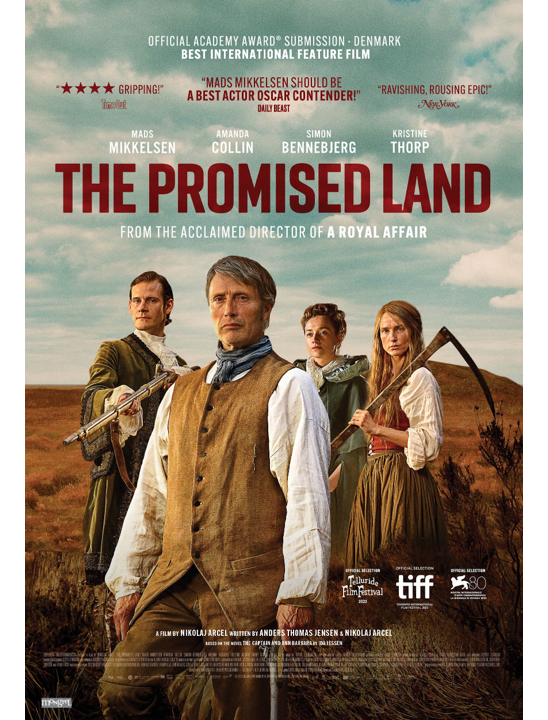




| Director | Nikolaj Arcel |
|---|---|
| Country | Denmark |
| Year | 2023 |
Directed by Nikolaj Arcel (A Royal Affair, 2012), The Promised Land premiered at the 2023 Venice Film Festival, entering the main competition and establishing itself as a bold, expansive historical epic. It was later selected as Denmark’s official submission for Best International Feature Film at the 2024 Academy Awards and made the shortlist of fifteen films.
The film also garnered acclaim at the European Film Awards—particularly for its acting, cinematography, and costume design. Filmed across Prague’s evocative locations (doubling for 18th-century Denmark), as well as Danish landscapes, the production merges Nordic realism with sweeping period aesthetics.
Set in 1755, The Promised Land follows Lt. Ludvig Kahlen (Mads Mikkelsen), a destitute former army officer who dreams of taming Jutland’s brutal heathland to earn a royal title. He secures the king’s backing—though local aristocrats and the inhospitable land threaten his every step.
With help from a runaway peasant couple, Ann Barbara (Amanda Collin) and Johannes (Morten H. Andersen), Kahlen fights to cultivate the land. He also reluctantly shelters Anmai Mus (Melina Hagberg), a Roma child, weaving them into an improvised family unit.
Opposition arises in the form of landowner Frederik de Schinkel (Simon Bennebjerg)—a sadistic rival whose cruelty erupts both ideologically and brutally. When Schinkel stages an armed assault on the settlement, Kahlen retaliates with deadly consequences.
Mads Mikkelsen is stoic to perfection, embodying Kahlen’s icy determination, buried grief, and dogged hope. His portrayal draws comparisons to a “Euro Gary Cooper”. Simon Bennebjerg’s gleefully loathsome De Schinkel—a baroque villain who orders a children’s choir to accompany brutal punishment—is irresistibly menacing.
Amanda Collin’s Ann Barbara brings emotional depth: her strength, cunning, and ultimately sacrificial love humanise the frontier’s moral compass. Meanwhile, Melina Hagberg’s Anmai Mus adds warmth and innocence, symbolising both displaced hope and the fragility of survival.
Stylistically anchored in the traditions of classic Westerns, The Promised Land channels rugged frontier tropes—lawless terrain, stern heroes, corrupt elites—but filters them through Nordic sensibilities and historical realism: bleak landscapes, class conflict, and existential perseverance.
At its core, the film explores hubris and ambition, the class struggle between upstarts and entrenched power, and the creation of found family in forms both tender and tragic. As RogerEbert.com notes, the film contains “bands of outlaws, sadistic aristocrats, and downtrodden peasants… historical epics like this really aren’t made anymore”.
With cinematography by Rasmus Videbæk, the film draws on the austere beauty of Jutland, framed in wide vistas and muted palettes that echo the isolation of its characters. Prague’s Baroque architecture stands in effectively for the royal court and official settings.
Arcel’s narrative unfolds in episodic beats—Moments of cultivation, confrontation, intimacy, and betrayal accumulate to form a morally charged mosaic. The screenplay, co-written with Anders Thomas Jensen, balances epic ambition with personal drama and delivers a sharply structured, richly textured tale.
Though anchored in 18th-century Denmark, the film resonates today through its examination of resilience, legacy, and authority. Kahlen’s struggle to cultivate inhospitable land becomes a metaphor for forging identity under adversity—and for challenging the inertia of entrenched elites.
For UK audiences attuned to historical dramas and moral reckonings—from The Last of the Mohicans to The Revenant—The Promised Land offers a uniquely Nordic spin: one where frontier myth meets harsh socio-political reality.
The Promised Land is a rare modern historical epic that delivers both spectacle and soul—a Nordic Western grounded in class struggle, human survival, and the toll of ambition. Mads Mikkelsen’s silent endurance, Ann Barbara’s fierce empathy, and the film’s moral complexity make it a compelling watch—one that lingers in memory long after the credits roll.
In an effort to reduce our paper usage, we stopped offering printed copies of our popular Film Notes at our screenings.
Instead, we are encouraging our members to read the Film Notes online. For those who wish to do so, it is still possible to print these pages prior to the film.
Alternatively, if you want to read the notes just before or just after the film, and also minimise your paper consumption, then you can scan the QR code to your phone and then download the webpage.
